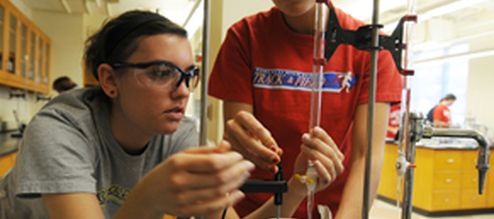Chemical Analysis of Jet Fuel Polar, Heteroatomic Species via High-Performance Liquid Chromatography with Electrospray Ionization-Mass Spectrometric Detection
Document Type
Article
Publication Date
2013
Publication Source
Energy and Fuels
Abstract
High-performance liquid chromatography (HPLC) with electrospray ionization–mass spectrometry (ESI–MS) was used to identify several classes of heteroatomic, polar compounds containing oxygen, nitrogen, and sulfur in a variety of jet fuel samples. While nitrogen, oxygen, and sulfur compounds are present only at low concentrations in jet fuel, they contribute significantly to some important fuel properties. These trace, heteroatomic species can provide positive (e.g., improved lubricity) or negative (e.g., reduced thermal stability) impacts. Reversed-phase liquid chromatography with ESI–MS detection allows for the polar components to be selectively ionized and subsequently identified, despite the complex hydrocarbon fuel matrix. Phenols and carbazoles are detected in negative-ion [M – H]− mode, while anilines, pyridines, indoles, and quinolines are observed in positive-ion [M + H]+ mode. Accurate mass measurements allow for the molecular formula of the polar components to be determined, while different structural classes of isomeric compounds could be determined via HPLC separation and the formation of derivatives. Derivatization shifts the retention time, species masses, and potentially, the ion charge formed of specific compound classes, allowing them to be positively identified. The usefulness and limits of HPLC with ESI–MS for quantitation of these fuel polar, heteroatomic species are also explored.
Inclusive pages
2390–2398
ISBN/ISSN
0887-0624
Publisher
American Chemical Society
Volume
27
Peer Reviewed
yes
Issue
5
Sponsoring Agency
Air Force Research Laboratory
eCommons Citation
Adams, Ryan K.; Zabarnick, Steven; West, Zachary J.; Striebich, Richard C.; and Johnson, David W., "Chemical Analysis of Jet Fuel Polar, Heteroatomic Species via High-Performance Liquid Chromatography with Electrospray Ionization-Mass Spectrometric Detection" (2013). Chemistry Faculty Publications. 43.
https://ecommons.udayton.edu/chm_fac_pub/43
COinS




Comments
This material is based on research sponsored by the Air Force Research Laboratory under agreement numbers F33615-03-2- 2347 and FA8650-10-2-2934. The views and conclusions contained herein are those of the authors and should not be interpreted as necessarily representing the official policies or endorsements, either expressed or implied, of the Air Force Research Laboratory or the U.S. Government.